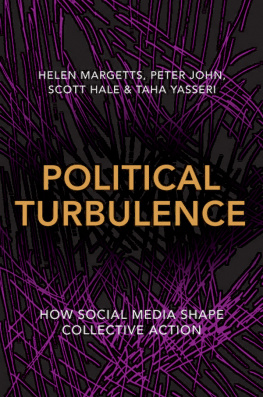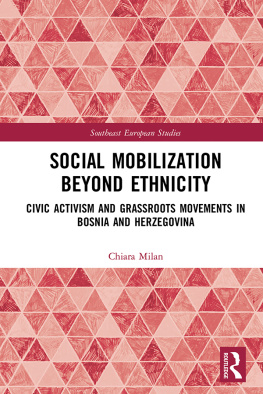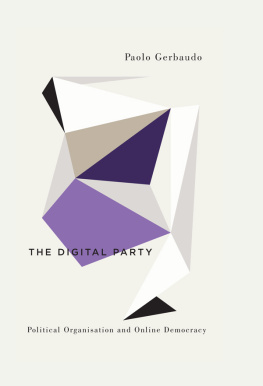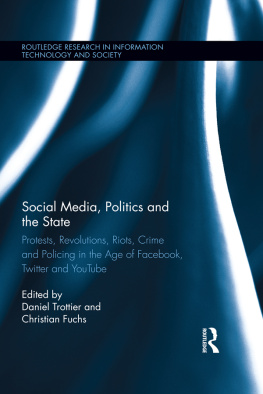
POLITICAL TURBULENCE
POLITICAL TURBULENCE
HOW SOCIAL MEDIA SHAPE COLLECTIVE ACTION
HELEN MARGETTS, PETER JOHN, SCOTT HALE & TAHA YASSERI
PRINCETON UNIVERSITY PRESS
Princeton and Oxford
Copyright 2016 by Princeton University Press
Published by Princeton University Press, 41 William Street,
Princeton, New Jersey 08540
In the United Kingdom: Princeton University Press, 6 Oxford Street, Woodstock, Oxfordshire OX20 1TW
press.princeton.edu
All Rights Reserved
ISBN 978-0-691-15922-5
Library of Congress Control Number: 2015938403
British Library Cataloging-in-Publication Data is available
This book has been composed in Avenir and Sabon LT Std
Printed on acid-free paper
Printed in the United States of America
10 9 8 7 6 5 4 3 2 1
FOR
OSCAR,
MIKE,
YUKO,
&
FARZANEH
CONTENTS
LIST OF ILLUSTRATIONS
LIST OF TABLES
ACKNOWLEDGEMENTS
The data for this book come from many different sources, and we have many people and organizations to thank for helping to supply it. The majority of the research was supported through Helen Margettss Professorial Fellowship, funded by the UK Economic and Social Research Council (grant RES-051-27-0331), which provided us with a great opportunity to amass large-scale, long-range data resources as well as to conduct experiments. We thank the ESRC, particularly for trusting in a research programme that promised to collect big data before the term was invented. Early on, we collaborated with the Rediscovering the Civic and Achieving Better Outcomes in Public Policy project, funded by ESRC, the Department of Communities and Local Government, and the North West Improvement and Efficiency Partnership (grant RES-177-025-0002), and an experiment that formed part of this programme is reported in in particular for copyediting, proofreading, and his invaluable comments.
We thank Princeton University Press for its support of the book, in particular the interest of the former editor, Chuck Myers, and then his successor Eric Crahan. We thank the presss anonymous reviewers for their engagement with the project and very helpful suggestions for revisions. We are very grateful to the editorial and marketing staff for the smooth processing of our manuscript.
We thank Tobias Escher and Stphane Reissfelder for the major part they played in the quasi-field experiment reported in .
We thank the House of Commons Procedure Committee and the Government Digital Service in the UK Cabinet Office for data discussion and sharing, and the opportunity to feed research insight into policy practice.
Our ideas progressed in the context of the Collective Action Online: Theories and Methods workshop at the ECPR Joint Sessions in Mainz 1116 March 2013 and the APSA panel on Collective Action and Social Media in Washington, 28 August 2014 (both convened by Lance Bennett and Helen Margetts), and we thank all the participants for their interest and discussion and reactions, particularly Mako Hill and Aaron Shaw.
We thank also the many researchers who have read early pieces or drafts, attended seminars or conference panels, or had important conversations with us about the research, particularly Jean-Luc Barbanneau (also for copyediting), Lance Bennett, Bruce Bimber, Josep Colomer, Patrick Dunleavy, Sandra Gonzlez-Bailn, Philip Howard; participants in the panel on Contemporary Collective Action Dilemmas at the European Consortium Political Research general conference in Potsdam, 10 September 2009; participants at a seminar at IN3, Open University of Catalonia, Barcelona, 7 October 2010 (particularly Rosa Borge and Jaume Lpez); participants in the Internet, Politics and Policy Conference on Big Data in Oxford in September 2012; and participants at the Paul Hirst Memorial Lecture given by Helen Margetts at Birkbeck College on 11 February 2014.
Finally, we thank deeply our families and friends for helping us to survive the turbulence that writing a book inevitably brings to everyday life.
POLITICAL TURBULENCE
CHAPTER 1
COLLECTIVE ACTION GOES DIGITAL
Everyone out against everything ran the headline of the leading Brazilian newspaper of 21 June 2013 in response to mass protests in over one hundred cities. Starting as a demonstration against increased bus fares, the protests grew into a movement against a range of deep issues in Brazilian society: inequality, corruption, lack of public services, and spiralling expenditure on the countrys commitment to host the 2016 Olympic Games as well as the 2014 World Cup. To the surprise of the world, the movement appeared to rise from the grassroots with no coordinating organization. Demonstrators refused to allow the flying of traditional political party flags in the protest marches, chanting, The people united dont need parties. When the president, Dilma Rousseff, asked to meet with the leaders of the demonstration, she was told, there are no leaders. This is not to say that such forms of collective action are not organized. Far from it, they are surprisingly well coordinated through the use of social media and other Internet-based platforms that allow users to generate and share content. In this way, states are being challenged by groups of citizens who have as their main weapon an ability to communicate and coordinate the resources of large numbers of people.
From wherever in the world you are reading this book, you are likely to have been touched by a mobilization that shares something with the one in Brazil; that is, having social media as a key tool of coordination. Movements like this have become a central feature of twenty-first-century politics, driving policy change, highlighting weaknesses in public services, bringing new political forces to the fore, acting as a focal point for dissatisfaction and discontent, campaigning for social rights, and challenging both democratic and non-democratic regimes.
From 2002, when large networks of young activists proved a major force in bringing the previously unknown Roh Moo-hyun to presidential power in South Korea, there has been a continual stream of examples. In 2003 millions of people were mobilized in eight hundred cities across the world, including two million in London on 15 February, to demonstrate against their states involvement in the Iraq War, the largest protest in human history until that time. In 2008 the United States elected its first black president, with record levels of turnout (particularly among black and first-time voters), community support, popular engagement, and large-scale fund-raising from the general public. Mass demonstrations took place in Iran in protest at allegedly rigged election results in 2009, organized and beamed across the world through digital communications.
There have been dramatic developments in political activity for democratic and social rights. On issues of gender, mobilizations have ranged from a successful petition calling for the depiction of women on banknotes in the United Kingdom to global campaigns against the practice of female genital mutilation. In the United States in 2014, large-scale protests against perceived racism in policing started after the shooting of an unarmed black man in Ferguson, Missouri, in the summer and resurfaced at each new shocking incident. In the same year, students and other protesters calling themselves the Umbrella Revolution campaigned for democratic change in Hong Kong, using social media extensively to organize and to connect in a global movement. Even where Internet usage is low or there is heavy censorship, social media have played a role in the dissemination of images of demonstrations or state violence to the outside world.
Next page







